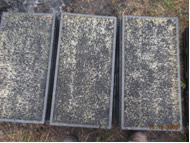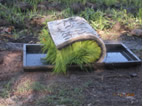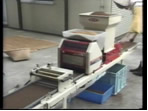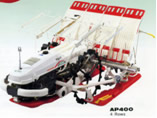Using the System of Rice Intensification at El Pedregal in Costa
Rica
by Mr. Oscar Montero (edited by Rena Perez)
The company "Agrícola Ganadera El Pedregal" was founded in the 1970s by my father, Carlos Andrés Montero, in the Pacific northwest of Costa Rica. The entire property of 223 hectares is devoted to agriculture, cattle raising and forest conservation.
The interest in transplanting rice using the new methodology known as "SICA" (SRI in English) reached Costa Rica when a Colombian, Mr. Diego Uribe Londoño, who was visiting Costa Rica, began trying to recover and repair some rice transplanting equipment. This machinery had had been imported 25 years ago from the Dominican Republic by two Costa Rican rice seed producers. For unknown reasons, these producers had abandoned the use of the mechanical transplanter and auxiliary equipment and had left the author the entire system.
During 2005, I began a series of studies to determine the possibility of transplanting using the SICA methods by adapting the mechanical transplanter for single seedlings. Previously, apart from the livestock, I cultivated cotton and sorghum, and produced hay, but never rice.
The equipment that we had consisted of 1) a motorized transplanting machine AP100 Yanmar (shown at right), 2) 2000 trays of 28 x 58 x 3 cm
(right side of photo at right), 3) machine that fills 300 trays per hour (center right of photo at right), 4) a multicultivator and 5) a 20 hp tractor with a "rotovictor."
Objective:
My objective (due to a shortage of manpower to transplant) was to modify the mechanical transplanter, AP100 Yanmar (see transplanter above), which was designed to sow between 3 and 5 seedlings, to sow a single seedling at a distance of 22x30 cm. And, with the help of the transplanter, to carry out the five basic recommendations for SICA.
Materials and methods:
1) Substrate:

 After studying different mixtures
for a period of one year, it was determined that the best is the residual
material-- the carbonized, controlled-combustion (not the burnt) rice hulls
obtained from the ovens used to dry rice.
After studying different mixtures
for a period of one year, it was determined that the best is the residual
material-- the carbonized, controlled-combustion (not the burnt) rice hulls
obtained from the ovens used to dry rice.
To clarify, this material is not ash. To this material, we add a “mychorrhiza” whose commercial name in Costa Rica is EcoMic. One problem we need to address in the future is that our tray filler (right) can fill enough trays (left) for planting five hectares a day, while our mechanical transplanter AP100 Yanmar can only handle (transplant) one hectare per day.
2) Seedlings:


200 grams pre-germinated seeds are required per tray (right). This produces at 10 days after germination a carpet of seedlings 15 cm high (left).
3) Land preparation: consists of using a rotador on leveled paddies, maintaining 10 cm of water for 8 days or more to control the weeds, decreasing the level of the water, application of fertilizer prior to another pass when the paddies are ready for transplant.
4) Transplanting: is mechanized with distances of 22 or 24 cm (within row) x 30 cm (between rows) and one, or sometimes, two plants per hill. The mechanical transplanter is designed for a fixed distance of 30 cm between rows and a variable distance within the row of 12 to 24 cm in order to accommodate the size of the seedling tray.
5) The agronomic aspects are: intermittent irrigation with drying out of the field (until the soil cracks) at 15 and 30 DAT (days after transplanting). We use entomopathogens for pest control and chili and minced garlic as insect repellents. A local herbicide is used, when necessary.
Results:
The national average for rice production is 4.2 mt/ha. However, using SICA with our system, we have achieved up to 8 tons of rice/ha paddy. What is more important, however, is that this is possible in an area traditionally infested with red rice.
Observations:
We are presently studying the available varieties that are best suited for use with SICA. Recently, El Pedregal joined the regional Chorotega group of CONARROZ (National Rice Corporation), the office that regulates and promotes all activities related to rice in Costa Rica. Programs will be instigated to promote the development of SICA, particularly for producers with less than 10 hectares. In addition, a workshop was recently offered to the regional directors of the Ministry of Agriculture and Cattle to promote SICA within the agricultural development program of the region Chorotega. During this workshop the need for the farmers to cultivate one hectare of rice for self-consumption was emphasized.
The author's email is elpedregal@costarricense.cr and with pleasure I will gladly be available for consultation-- however only in Spanish.
Mr. Oscar Montero
Agriculture & Cattle Farm “El Pedregal”
elpedregal@costarricense.cr


